Executed Leaders of the 1916 Rebellion
James Connolly
(1868-1916)
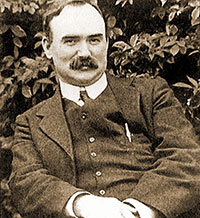 Born in Edinburgh on June 5th, 1868, Connolly first went to Ireland as a fourteen year old member of the British Army. He married in Scotland where he became involved in Socialism. In 1896 he moved to Dublin where he founded the Irish Socialist Republican Party and also started a newspaper the Workers’ Republic. He spent seven years in America where he lectured and organized. He was an organizer for the Wobblies in the New York area.
Born in Edinburgh on June 5th, 1868, Connolly first went to Ireland as a fourteen year old member of the British Army. He married in Scotland where he became involved in Socialism. In 1896 he moved to Dublin where he founded the Irish Socialist Republican Party and also started a newspaper the Workers’ Republic. He spent seven years in America where he lectured and organized. He was an organizer for the Wobblies in the New York area.
Connolly returned to Ireland in 1910 and campaigned for the Socialist Party. Jim Larkin appointed him as Ulster Organiser for the ITGWU in Belfast but in 1913 he came back to Dublin to help during the Lockout. Connolly was one of the founders of the Irish Citizen Army. Throughout his life he wrote and published extensively on Irish and socialist issues. Tom Clarke was always sure to include Connolly and the ICA in any IRB or Volunteer celebrations, e.g. Rossa’s funeral in 1915 or the Wolfe Tone commemoration.
During the Easter Rising he was appointed Commandant-General of the Dublin brigade, directing the Army of the Irish Republic in the GPO. Badly wounded in two separate incidents Connolly was executed strapped to a chair on 12th May 1916.
Patrick Pearse
(1879-1916)
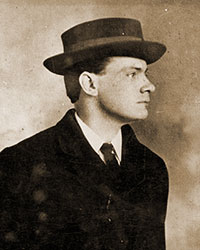 Patrick Henry was born in Dublin on November 10th, 1879, to an English father, the sculptor James Pearse. Patrick had little time for the family business but was interested in Irish cultural matters in his teenage years. In 1898 Pearse became a member of the Executive Committee of the Gaelic League. He graduated from the Royal University in 1901 with a degree in Arts and Law. Pearse’s literary output was constant, and he published extensively in both Irish and English, becoming the editor of An Claidheamh Soluis, the newspaper of the Gaelic League.
Patrick Henry was born in Dublin on November 10th, 1879, to an English father, the sculptor James Pearse. Patrick had little time for the family business but was interested in Irish cultural matters in his teenage years. In 1898 Pearse became a member of the Executive Committee of the Gaelic League. He graduated from the Royal University in 1901 with a degree in Arts and Law. Pearse’s literary output was constant, and he published extensively in both Irish and English, becoming the editor of An Claidheamh Soluis, the newspaper of the Gaelic League.
Pearse was connected with Rosmuc where he eventually employed some locals to build a cottage for him to enable his continued studies in the language. He also spent time on the Aran Islands and it was here that he first met Thomas MacDonagh. He condemned the English educational system as in The Murder Machine, and established two schools, Scoil Éanna and Scoil Ita, devoted to the education of Irish children through the Irish language.
He was a poet, a dreamer, an educator and abstained from drink and smoking. One of the founder members of the Irish Volunteers, and co-author of the Proclamation of Independence, Pearse was the President of the Provisional Government of the Irish Republic and was Commander in Chief in the GPO. He was executed on May 3rd, 1916.
William Pearse
(1881-1916)
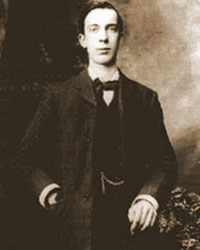 William was born on November 15th 1881, the younger brother of Patrick Pearse. After receiving his early education in Westland Row CBS, Willie decided to pursue an artistic career and studied at the Metropolitan School of Art in Dublin. His father James, an Englishman, was a well-respected sculptor and Willie obviously inherited much of his skills. Willie’s work can be seen in the Mortuary Chapel, St Andrew’s Church, Westland Row. A more accessible look at one of his pieces can be enjoyed in Stephens Green under the bust of the poet Mangan, where Willie has carved Roisín Dubh in white marble.
William was born on November 15th 1881, the younger brother of Patrick Pearse. After receiving his early education in Westland Row CBS, Willie decided to pursue an artistic career and studied at the Metropolitan School of Art in Dublin. His father James, an Englishman, was a well-respected sculptor and Willie obviously inherited much of his skills. Willie’s work can be seen in the Mortuary Chapel, St Andrew’s Church, Westland Row. A more accessible look at one of his pieces can be enjoyed in Stephens Green under the bust of the poet Mangan, where Willie has carved Roisín Dubh in white marble.
To a certain extent he has been overshadowed by his brother but Willie was every bit as enthusiastic a revolutionary, teacher and language enthusiast as Patrick. In fact he taught at Saint Enda’s school on a full time basis from 1913 onwards. When his brother became Director of Organisations in the Volunteers Willie and Thomas MacDonagh were left in effective charge of the school. Desmond Ryan, wrote that “William Pearse stepped forward to uphold the college in his brother’s way, and with his brother’s ideals and methods… The debt St. Enda’s owes to William Pearse can scarcely be over-estimated…”
Willie’s rank was as a captain in the Volunteers during the Easter Rising of 1916. Willie was stationed in the GPO, where he stood by Patrick’s side as his ADC until the surrender order came. After the Rising, Willie was taken to Richmond Barracks where he was court-martialed. Of all the revolutionaries who were executed in 1916 Willie was the only one who pleaded guilty to the charge: “Did an act to wit did take part in armed rebellion and in the waging of war against His Majesty the King, such an act being of such a nature as to be calculated to be prejudicial to the Defence of the Realm and being done with the intention and for the purpose of assisting the enemy.”
Despite his guilty plea which is often perceived as a desire to accept the same fate as his brother, Willie insisted that he “had no authority or say in the arrangements for the starting of the rebellion. I was throughout – only a personal attaché to my brother PH Pearse. I had no direct command.”
Willie was executed in Kilmainham Gaol on the 4th of May 1916.
Seán MacDiarmada
(1884-1916)
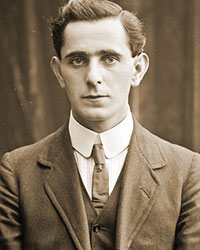 Born February 28th, 1884 in Kiltyclogher, Leitrim, MacDiarmada emigrated to Glasgow in 1900, and from there to Belfast in 1902 where he worked on the trams. A member of the Gaelic League, he was very active in the Dungannon Clubs with Bulmer Hobson and Dennis McCullough. He joined the Irish Republican Brotherhood in 1906 while still in Belfast. As these formed into Sinn Fein he was a tireless organizer for the party in it’s early years, later transferring to Dublin where he developed a close personal and political friendship with Thomas Clarke.
Born February 28th, 1884 in Kiltyclogher, Leitrim, MacDiarmada emigrated to Glasgow in 1900, and from there to Belfast in 1902 where he worked on the trams. A member of the Gaelic League, he was very active in the Dungannon Clubs with Bulmer Hobson and Dennis McCullough. He joined the Irish Republican Brotherhood in 1906 while still in Belfast. As these formed into Sinn Fein he was a tireless organizer for the party in it’s early years, later transferring to Dublin where he developed a close personal and political friendship with Thomas Clarke.
He gave lectures in Glasgow and Edinburgh and often suffered physical abuse especially in parts of Ireland where the Hibernians and Irish Parliamentary Party were strong. He was unrelenting in his re-organisation of the IRB and through his travels across Ireland became the movement’s best-known and most popular personality He ran the IRB newspaper Irish Freedom in 1910. Although MacDiarmada was afflicted with polio in 1912, he was appointed as a member of the provisional committee of Irish Volunteers from 1913, and was Secretary of the Supreme Council of the IRB, member of the Military Council and member of the Provisional Government. He was stationed in the GPO during the Rising. He was executed on 12 May 1916.
Joseph Plunkett
(1887-1916)
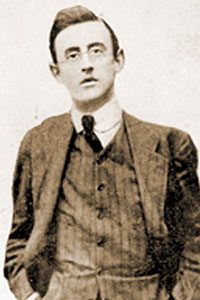 Born in Dublin in November 1887 he was a sickly child but a keen scholar. The son of a papal count Plunkett was initially educated in England. He returned to Ireland and graduated from UCD in 1909. After his graduation Plunkett spent two years traveling in Europe due to ill health, returning to Dublin in 1911. Thomas MacDonagh worked with Plunkett as co-editor on the Irish Review and director of the Irish Theatre. He joined the Irish Volunteers in 1913.
Born in Dublin in November 1887 he was a sickly child but a keen scholar. The son of a papal count Plunkett was initially educated in England. He returned to Ireland and graduated from UCD in 1909. After his graduation Plunkett spent two years traveling in Europe due to ill health, returning to Dublin in 1911. Thomas MacDonagh worked with Plunkett as co-editor on the Irish Review and director of the Irish Theatre. He joined the Irish Volunteers in 1913.
Plunkett’s farm, Larkfield in Kimmage, was used as one of the clearing stations for the cargo of arms landed at Howth in 1914. It was also used as a training camp for young men who had been invited by the Plunkett family to Ireland from Britain to avoid conscription during World War I. He was brought into the IRB in 1914. Plunkett traveled to Germany to meet Roger Casement in 1915. During the planning of the Rising, Plunkett was appointed Director of Military Operations, with overall responsibility for military strategy. Joseph Plunkett suffered from ill health and had had an operation for glandular tuberculosis only days before the Rebellion, struggling out of his sick bed to partake in it. He was assisted by a young and unknown IRB volunteer who acted as his ADC, Michael Collins.
Joseph Plunkett was a member of the Military Council of the Provisional Government and of the Provisional Committee of the Irish Volunteers. He married his sweetheart, the artist Grace Gifford, in Kilmainham Gaol just hours before his execution on 4 May 1916.
Edward Daly
(1891-1916)
 Born in Limerick on 28th or 25th February 1891 he was the only boy amongst nine sisters. Daly’s family had a history of republican activity; his father had taken part in the Rising of 1867. He knew Tom Clarke through his uncle John Daly who shared a cell with the “dynamiter”– they were brought closer through Tom’s marriage to his sister Kathleen Daly. Later he worked for the chemist wholesalers on Westmoreland Street, May Roberts.
Born in Limerick on 28th or 25th February 1891 he was the only boy amongst nine sisters. Daly’s family had a history of republican activity; his father had taken part in the Rising of 1867. He knew Tom Clarke through his uncle John Daly who shared a cell with the “dynamiter”– they were brought closer through Tom’s marriage to his sister Kathleen Daly. Later he worked for the chemist wholesalers on Westmoreland Street, May Roberts.
The Christian Brothers who considered him “not by any means a brilliant pupil” educated him. He tried working in Glasgow as a baker’s apprentice and then moved to Dublin and worked for some time in Clarke’s shop with his sister. He was one of the first to join the Volunteers and helped to organize for the Rossa funeral in 1915. In the weeks leading up to the Rising, at Seán MacDiarmada’s request he worked full time for the Volunteers.
Ned was commander of the Volunteers First Battalion who were based around the Four Courts area of Dublin during 1916. Daly raided the Bridewell Barracks and found twenty-four members of the Dublin Metropolitan Police hidden in their cells. He also raided the Linenhall Barracks, a building which housed the Army Pay Corps, which his men then set on fire in order to disrupt the system. Ned Daly and his men fought pitched battles with the British around the narrow streets of Smithfield and the Market area of Dublin. After the eventual surrender of the 1st Battalion an unfortunate incident occurred when British soldiers apparently lost control of themselves. They battered their way into houses along North King Street and shot male residents indiscriminately. The discovery of a shallow grave after the Rising that contained two civilian bodies later led to an investigation, which served to help the decisive shift of public opinion against the British forces. On the other hand Daly had captured Col J.P. Brereton and held him in the Four Courts. Later Brereton commended the garrison for their behavior and said “he was treated with kindness by the insurgents.”
Ned Daly was taken to Kilmainham Gaol and took the dubious honour of being the youngest executed – on the 4th of May 1916.
Éamonn Ceannt
(1881-1916)
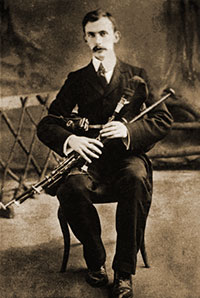 Born Edward Kent into a family of seven children, in Glenamaddy, north Co. Galway on 21st September 1881. His father brought the family to Dublin when he retired from the RIC in 1892. In Dublin he became an accomplished uilleann piper and a language enthusiast. He changed his name to the Irish version when he joined the Gaelic League. In February 1900 Ceannt co-founded Cumann na bPíobairí and was to become it’s honorary secretary. In 1907 he joined the Dublin branch of Sinn Féin. He played the pipes for the Pope Pius during a visit to Rome in September 1908. He also worked as an accountant for Dublin Corporation.
Born Edward Kent into a family of seven children, in Glenamaddy, north Co. Galway on 21st September 1881. His father brought the family to Dublin when he retired from the RIC in 1892. In Dublin he became an accomplished uilleann piper and a language enthusiast. He changed his name to the Irish version when he joined the Gaelic League. In February 1900 Ceannt co-founded Cumann na bPíobairí and was to become it’s honorary secretary. In 1907 he joined the Dublin branch of Sinn Féin. He played the pipes for the Pope Pius during a visit to Rome in September 1908. He also worked as an accountant for Dublin Corporation.
In 1911 he was on a committee (to protest the proposed visit of George V), which included Pearse, MacDiarmada and MacDonagh. He was an original founder of the Irish Volunteers, and was involved in the Howth gunrunning operation of 1914. He was a significant contributor to Pearse’s newspaper An Barr Buadh, the Trumpet of Victory. On the 12th of December 1912 he was sworn into the IRB. He later became a member of the IRB Military Council and a signatory of the Proclamation.
He commanded the 4th Battalion in the South Dublin Union during the Rising. Ceannt had under his command such luminaries as Cathal Brugha and WT Cosgrave. Although he had very few volunteers at his disposal he commanded one of the few areas that held out until the GPO surrender. He was executed on 8 May 1916.
Seán Heuston
(1891-1916)
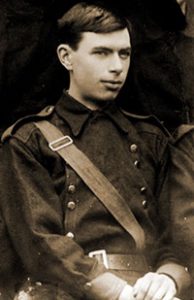 Born Jack Heuston (and often referred to as JJ) in Dublin on 21st February 1891. Just like Con Colbert, Seán was educated in CBS North Richmond Street. In 1907 at the age of 16 he secured a job with the GSW Railway as a clerk. He worked at the Limerick Goods Depot until 1913 when he was transferred to Kingsbridge, which is now named, in his honour as Heuston Station. During his six years in Limerick he organized the Fianna in that city and using his “proficiency as a book-keeper” arranged for members who could not afford to buy their uniforms to do so by paying small weekly sums. He also gave Irish history lectures and ran courses in small arms training, signaling and the Irish language. He was the main source of income for the three women who he lived with in Dublin as his father was estranged and living in London.
Born Jack Heuston (and often referred to as JJ) in Dublin on 21st February 1891. Just like Con Colbert, Seán was educated in CBS North Richmond Street. In 1907 at the age of 16 he secured a job with the GSW Railway as a clerk. He worked at the Limerick Goods Depot until 1913 when he was transferred to Kingsbridge, which is now named, in his honour as Heuston Station. During his six years in Limerick he organized the Fianna in that city and using his “proficiency as a book-keeper” arranged for members who could not afford to buy their uniforms to do so by paying small weekly sums. He also gave Irish history lectures and ran courses in small arms training, signaling and the Irish language. He was the main source of income for the three women who he lived with in Dublin as his father was estranged and living in London.
Along with Con Colbert, Heuston was involved in the education of the schoolboys at Scoil Éanna, organising drill and musketry exercises. A very small section of the First Battalion of the Volunteers under Heuston commandeered the Mendicity Institute on the orders of Connolly. For this command the nineteen-year-old Heuston was executed in Kilmainham Gaol on the 8th of May 1916. Often considered to have been the youngest to be executed by the British, Kathleen Clarke points out that her brother Ned was a few days younger than Seán.
Thomas James Clarke
(1857-1916)
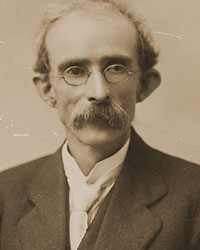 Born in Hurst Castle on the Isle of Wight, March 11th 1857, Clarke’s father, a Galway man, was a sergeant in the British army. When Tom was ten years of age his family moved to Dungannon in Co. Tyrone. At sixteen he formed a nationalist club, which soon attracted IRB members, and a visit to his parents from the RIC caused a family squabble, which resulted in Tom leaving for America in 1881. During his time in America as a young man, he joined Clan na Gael.
Born in Hurst Castle on the Isle of Wight, March 11th 1857, Clarke’s father, a Galway man, was a sergeant in the British army. When Tom was ten years of age his family moved to Dungannon in Co. Tyrone. At sixteen he formed a nationalist club, which soon attracted IRB members, and a visit to his parents from the RIC caused a family squabble, which resulted in Tom leaving for America in 1881. During his time in America as a young man, he joined Clan na Gael.
In 1883 he arrived in England as “Henry H Wilson” just at the beginning of the IRB bombing campaign. He spent fifteen years in Pentonville. Released in 1898, a year later in America he married Kathleen, the niece of his old cellmate John Daly. His best man was John MacBride. Clarke continued his association with the Clan in America, and this link would prove very useful in the run up to the Rising. He returned to Dublin 1907, opened a couple of newsagents, and set about reorganizing the IRB with Seán MacDiarmada.
Clarke encouraged IRB involvement in the foundation of the Irish Volunteers in the Rotunda in 1913. He held the post of Treasurer to the IRB and was a member of the Supreme Council from 1915. In July of 1915 Clarke organized the funeral of O’Donovan Rossa, the committee included many leading lights that would have a role in the Easter Rising. For instance, Thomas MacDonagh was the Chief Marshal and Patrick Pearse gave the oration at the graveside. His drooping moustache and quiet manner lent an air of indifference to him but it has been said that the largest file in Dublin Castle was marked Tom Clarke. As the oldest and most respected member of the Military Council Clarke was given the honour of signing the Proclamation first. He was executed on 3 May 1916.
Thomas MacDonagh
(1878-1916)
 A native of Cloughjordan, Tipperary, MacDonagh spent the early part of his career as a teacher. Having met Pearse on the Aran Islands he moved to Dublin to study and joined the teaching staff of St. Enda’s. Later having taken a Masters Degree in arts he lectured in English at the National University. MacDonagh was a poet and his play When the Dawn is Come was produced at the Abbey theatre.
A native of Cloughjordan, Tipperary, MacDonagh spent the early part of his career as a teacher. Having met Pearse on the Aran Islands he moved to Dublin to study and joined the teaching staff of St. Enda’s. Later having taken a Masters Degree in arts he lectured in English at the National University. MacDonagh was a poet and his play When the Dawn is Come was produced at the Abbey theatre.
He was appointed director of training for the Irish Volunteers in 1914, later joining the IRB. Tom was co-opted to the Military Council only weeks before the Rising. He was commander of the Second Battalion of Volunteers that occupied Jacob’s during the Rising. Like his friend Joseph Plunkett he also edited the Irish Review and was an Irish Theatre Director. MacDonagh was often described as a wit, enthusiastic family man with never an unkind word to say about anyone. He was executed on 3 May 1916.
Michael Mallin
(1874-1916)
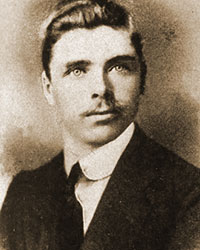 Born in Dublin his early youth was spent in the British Army as a drummer boy. He was stationed in India and was promoted to the rank of NCO. There is a story that he was the only witness amongst 14 who claimed that a certain Indian nationalists had attacked a British official. Mallin claimed that the person who was arrested was innocent but on the testimony of the others the man was executed.
Born in Dublin his early youth was spent in the British Army as a drummer boy. He was stationed in India and was promoted to the rank of NCO. There is a story that he was the only witness amongst 14 who claimed that a certain Indian nationalists had attacked a British official. Mallin claimed that the person who was arrested was innocent but on the testimony of the others the man was executed.
After 14 years in the service he returned to Dublin. He became a silk weaver and became involved in organized Labour eventually being elected as Secretary to the Silk Wavers Union. During the Lockout of 1913-14 Mallin became involved with James Connolly and the ICA. The departure of Jack White to the Irish Volunteers saw Mallin become the main trainer of the small force. He wrote for the Workers’ Republic and gave endless lectures on tactics and was eventually made Chief of Staff of the Citizen Army.
Mallin was also a crack shot no doubt thanks to his training in the British Army. He commanded the Stephen’s Green area with Markievicz, as his second. The taking of the green as opposed to the surrounding buildings did not show a great tactician but nonetheless those who were under him said he fought bravely. Mallin left a wife and small children behind when he was executed on 8 May 1916. His last letter to his wife and children is probably one of the most poignant of all the final words written by the executed leaders.
Con Colbert
(1888-1916)
 Born Cornelius Colbert in Monalena, Limerick in 1888, Colbert was raised in Athea in the same county. His family moved to Dublin when he was 13. He went to CBS North Richmond Street and later worked as a baker in Kennedy’s. He was a fluent Irish speaker and was passionate about Irish history. He was present on 16th August 1909 when Fianna Éireann were founded at 34 Lower Camden Street. He became a Captain and was given charge of a city branch.
Born Cornelius Colbert in Monalena, Limerick in 1888, Colbert was raised in Athea in the same county. His family moved to Dublin when he was 13. He went to CBS North Richmond Street and later worked as a baker in Kennedy’s. He was a fluent Irish speaker and was passionate about Irish history. He was present on 16th August 1909 when Fianna Éireann were founded at 34 Lower Camden Street. He became a Captain and was given charge of a city branch.
Colbert headed an IRB circle composed of Fianna boys. He was elected on to the Executive of the Irish Volunteers and became Captain of F Co, 4th Batt. Pearse called him “the gallant Captain Colbert” and asked him to drill the St Enda’s boys. A dedicated pioneer, Colbert was known not to drink or smoke and even gave up dancing during Lent. There was a joke in Na Fianna: “Colbert swore last night, he called a man a pick axe.” He first commanded Watkins Brewery, then moved to Marrowbone Lane distillery. He assumed command of the whole garrison upon their surrender on Sunday, 30 April 1916. He famously moved the piece of white paper that was being pinned to his chest for the firing squad to aim at saying “would it not be better nearer the heart.” He was executed on May 8th 1916 in his 28th year. Limerick railway station is named in his honour as Colbert Station.
Roger Casement
(1864-1916)
 Born in Sandycove, Dublin on 1st September 1864. The Casements were Ulster Protestants with an ancestral home near Ballycastle, Co. Antrim. His father, an army officer died when Roger was a baby and his mother passed away when he was nine. Casement’s uncle in Antrim raised him. At the age of 20 he joined a ships company to Africa. He traveled widely in Africa and in 1892 at the age of 28 he joined the British Civil Service. A few years later he was made Consul in the Congo Free State and eventually Casement was knighted for his services to the British consulate. He campaigned and exposed the horrific cruelty and regime that forced native workers into slavery on the rubber plantations in the Congo and later again in South America bringing international attention with his reports.
Born in Sandycove, Dublin on 1st September 1864. The Casements were Ulster Protestants with an ancestral home near Ballycastle, Co. Antrim. His father, an army officer died when Roger was a baby and his mother passed away when he was nine. Casement’s uncle in Antrim raised him. At the age of 20 he joined a ships company to Africa. He traveled widely in Africa and in 1892 at the age of 28 he joined the British Civil Service. A few years later he was made Consul in the Congo Free State and eventually Casement was knighted for his services to the British consulate. He campaigned and exposed the horrific cruelty and regime that forced native workers into slavery on the rubber plantations in the Congo and later again in South America bringing international attention with his reports.
Casement had become a member of the Gaelic League in 1904, and often wrote articles under the pen name “Sean Bhean Bhocht.” He left the British consular service in 1913 and was an original founder of the Volunteers in the Rotunda. In 1914 he wrote a piece for the Irish Review under the editorship of MacDonagh and Plunkett with the theme of England’s difficulty being Ireland’s opportunity. Casement went to America and from there to Germany ostensibly to raise an Irish Brigade from Irish POW’s. He was 18 months there and to a certain extent lost contact with the IRB idealists but Plunkett came to Germany to discuss matters and assist with the procurement of arms for the Rising.
Casement came to Kerry on board U-19, but was captured on Good Friday. Casement was held in Pentonville Gaol in London, where he was tried on charges of High Treason under a Statute that was 565 years old. On the 3rd of August he was hanged in Pentonville. His body was returned to Ireland in 1965 and despite his wishes to be interred in Antrim he was buried in Glasnevin.
Thomas Kent
(1865-1916)
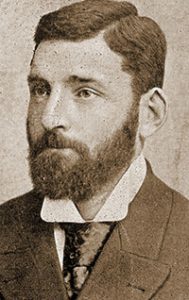 Thomas Kent was born in Bawnard House, Castlelyons, Co. Cork in 1865. His family had a long tradition of fighting against the injustices suffered by small farmers and fought particularly during the Land War. When Thomas was 19 he emigrated to Boston where he remained for some years working as a church furniture maker until he was forced to return to Cork due to deterioration in his health.
Thomas Kent was born in Bawnard House, Castlelyons, Co. Cork in 1865. His family had a long tradition of fighting against the injustices suffered by small farmers and fought particularly during the Land War. When Thomas was 19 he emigrated to Boston where he remained for some years working as a church furniture maker until he was forced to return to Cork due to deterioration in his health.
Upon his return he spent some months in prison for agitation. It was not unusual for a Kent brother to be in jail and the Royal Irish Constabulary spent much of their time harassing and watching the Kent household. After the split in the Nationalist movement due to the Parnell affair the family seem to have taken a back seat until Thomas joined the Gaelic League and soon afterwards the Irish Volunteers when they were established in 1913.
John Redmond, the recruiting sergeant for the British Army and leader of the Home Rule Party was due to give a speech in the village of Dungourney. The Kent brothers invited Terence MacSwiney to speak on an anti-recruitment platform at the same time. The local GAA members and Volunteers marched through Redmond’s meeting holding their hurleys on their shoulders in imitation of rifles. That evening a company of Irish Volunteers was formed in Dungourney much to the consternation of Redmond and the local police. It was only a few weeks after this that the police arrested and remanded Thomas. Despite their best efforts he was acquitted but the police raided Bawnard House a few days after his release and found weapons and ammunition. Thomas Kent was sent to prison again, this time for two months.
Later, when news of the Rising in Dublin reached the Kent brothers they waited in some neighboring houses for orders to mobilize. These orders never came mainly thanks to MacNeill’s countermanding order and to the fact that JJ O’Connell came to Cork with the order to stand down. By the 2nd of May, four of the brothers, Thomas, William, Richard and David returned to Bawnard House. At dawn, the police came to the house with orders to arrest the whole family. They had surrounded the house and called for the four brothers to come outside. Thomas replied that they were soldiers of the Irish Republic and that there would be no surrender. To this the police retorted with a volley of shots. For the next three hours a battle ensued but the Kent’s, with only three shotguns and one rifle to their name, eventually ran out of ammunition. Mrs. Kent was in the house throughout the battle and not only gave great encouragement to her sons but helped to clean and cool their weapons.
The outcome of the fight was that one of the brothers David was wounded and a Head-Constable was killed. In the confusion of the Kent’s surrender, the athletic Richard who had suffered some mental health problems in his past, made a dash for the woods rather than return to prison. He was mown down and killed in a fusillade of RIC rifle fire. The constables were enraged and threw the two remaining brothers who could stand up, against a wall, and were going to shoot them but for the intervention of a military officer. On the 4th of May, William and Thomas were court-martialed. William was acquitted but Thomas was convicted and sentenced to death for taking “part in an armed rebellion…for the purpose of assisting the enemy.” Thomas Kent was executed by the British in Cork Detention Barracks on the 9th of May 1916.
Michael O’Hanrahan
(1877-1916)
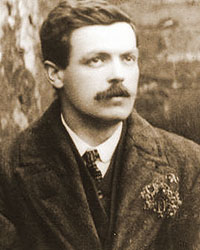 Born in New Ross, Wexford on St Patrick’s Day in 1877. His father Richard had taken part in the Fenian Rising of 1867. As a child the family moved to Carlow where Michael received his education in a CBS and later he went to the College Academy. He was hoping to join the Civil Service but would not take the Oath.
Born in New Ross, Wexford on St Patrick’s Day in 1877. His father Richard had taken part in the Fenian Rising of 1867. As a child the family moved to Carlow where Michael received his education in a CBS and later he went to the College Academy. He was hoping to join the Civil Service but would not take the Oath.
As a young man, O’Hanrahan showed great promise as a writer, becoming heavily involved in the promotion of the Irish language. He founded the first Carlow branch of the Gaelic League, and published two novels, A Swordsman of the Brigade and When the Norman Came. Upon coming to Dublin he had various jobs such as working for an Irish publisher, freelance journalism etc. He also joined Sinn Féin in Dublin and was quite active with the party for a few years and sat on its National Council.
Like many of the other executed leaders, he joined the Irish Volunteers from their inception. Hard work and enthusiasm resulted in his promotion to National Quartermaster and for some time before the Rising he was a full time member of Volunteer HQ Staff at 2 Dawson St. During the fight in ’16 he was second in command to Thomas MacDonagh at Jacob’s biscuit factory although this position was largely usurped by the arrival of MacBride.
Curiously O’Hanrahan had a nasty accident in Jacobs when he tumbled down a flight of stone steps and received concussion. He feared that MacDonagh might send him to hospital so he played the incident down. His brother Henry also fought in Jacobs – it has been recorded that Michael was a close personal friend of Thomas MacDonagh. His execution took place on 4 May 1916. The Carlow museum has a small section dedicated to their adopted son.
John MacBride
(1865-1916)
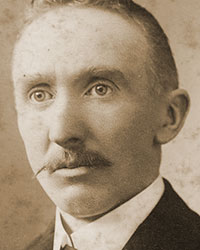 Born at The Quay, Westport, Mayo on 7th May 1865. MacBride attempted to become a medical doctor but gave up his studies and came to work in a chemist in Dublin. He joined the IRB and was involved in the early days of the GAA. Through the Celtic Literary Society he became close to Arthur Griffith with whom he remained close to throughout his life. On behalf of the IRB he went to America in 1896. He was best man at Tom Clarke’s wedding in New York in 1899.
Born at The Quay, Westport, Mayo on 7th May 1865. MacBride attempted to become a medical doctor but gave up his studies and came to work in a chemist in Dublin. He joined the IRB and was involved in the early days of the GAA. Through the Celtic Literary Society he became close to Arthur Griffith with whom he remained close to throughout his life. On behalf of the IRB he went to America in 1896. He was best man at Tom Clarke’s wedding in New York in 1899.
He went to South Africa where he fought alongside the Irish Transvaal Brigade against the British in the 2nd Boer War. The Boer Government gave him the rank of Major and the Irish Brigade became more commonly known as MacBride’s Brigade. Connolly, Griffith and Maude Gonne had been active campaigning against the Boer War. Much to Yeats’ horror MacBride married his muse, Gonne, in 1903. He was not a member of the Irish Volunteers, but during the Rising he was second to Thomas MacDonagh in Jacob’s biscuit factory. He was executed on 5 May 1916.
